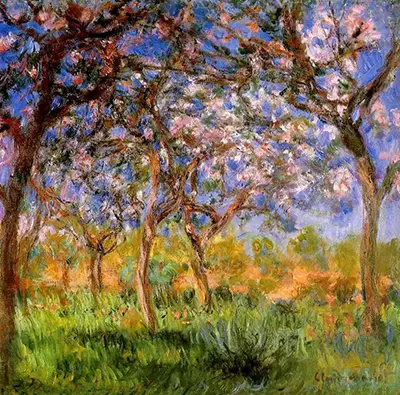Monet adored his house in Giverny, and he was passionate about the garden he created there. Even when he was away from home he made sure he knew what was happening in the garden and gave instruction for its upkeep from wherever he was.
Monet moved into the large house in Giverny, which is located approximately 80km from Paris, in 1883. He embraced a passion for gardening and botany alongside his work as an artist.
He lived in this house for 43 years, up until the time of his death, and during his years there he created a magnificent garden filled with flowers and trees. He also introduced a Japanese area with a lily pond and wooden bridge. During these years the artist became fascinated with nature, and he was enthralled with the changing light that altered with the time of day, with the season and with the weather.
He was obsessed with capturing a single moment in time, and wanted to paint the unique light, the shadows and reflections that presented themselves for a fleeting second, before shifting and changing. The eye could see these subtle differences in light and shade, but painting them before they changed proved to be a challenge he enjoyed.
Monet painted his lily pond at Giverny over 250 times as he witnessed the scene throughout the year in his well-known series of works. It was almost an obsession. He also captured the gardens at Giverny multiple times, painting different groups of flowers such as his series of Irises. Van Gogh also famously captured Irises.
Giverny in Springtime is one of these paintings and it depicts an area of the garden when the trees are heavy with pink blossom and the sky is deep blue. The colours are bright and playful, with pinks, blues, greens and yellows all featuring.
Monet excelled at painting ‘en plein air’ meaning in the fresh air and not in a studio with artificial light. He preferred this way of working, as did other Impressionist artists, because it brought them into the middle of nature, a place where the temperature, breezes and aromas affect the artist at work. Painting outside does have some limitations however, as all materials need to be transported to the scene and the changing weather can halt work.
There is a need to paint or sketch quickly which produces a more fluid look to a piece. In the Spingtime at Giverny work, the trees appear to have some movement to them as if they are swaying gently in the breeze. Paint is dabbed on in layers to add textured details, creating loose blossom flowers in a style used frequently by Monet.
The long, lush grasses under the trees have been painted using thick and simple strokes, the colours are unmixed and were perhaps squeezed straight from the tube onto the brush. There is a sense of speed and excitement in this painting, but it is also very clear what the scene is about.
From afar, the viewer can see shade, especially under the tree in the foreground, and close up, the simple brush strokes that appear casually applied portray gentle movement. The viewer can imagine warm air, a gentle breeze and the smell of blossom.


